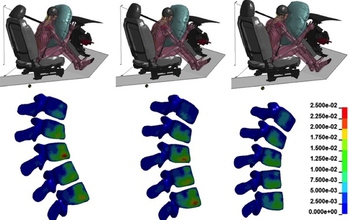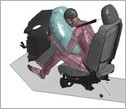News Release 15-142
Crash test simulations expose real risks
Using Blacklight supercomputer, researchers gain new insights into crash injuries and ways to mitigate them

Simulations reproduce real-world injury patterns and predict details better than crash test dummies.
November 12, 2015
This material is available primarily for archival purposes. Telephone numbers or other contact information may be out of date; please see current contact information at media contacts.
More than 33,000 Americans die in motor vehicle crashes annually, according to the Centers for Disease Control and Prevention. Modern restraint systems save lives, but some deaths and injuries remain--and restraints themselves can cause some injuries.
"Crash-test dummies" help engineers design safer cars, but provide only limited information about forces the body experiences during impact. Computer models of vehicle crashes, on the other hand, provide more sophisticated information on how to improve restraints and other safety systems. The models also help researchers simulate the effects of thousands of variables that would be far too slow to test in physical crash tests.
"There's really limited information you can get from a crash-test dummy--you get only about 20 data points," says Ashley A. Weaver, an assistant professor at the Virginia Tech-Wake Forest University Center for Injury Biomechanics and a former National Science Foundation (NSF) graduate research fellow. "The human body model gives us much more, predicting injuries in organs that aren't in that dummy, such as lung contusions."
The Crash Injury Research and Engineering Network (CIREN) has created a database of real-world vehicle crashes for researchers to test with computer models. Working with Joel Stitzel and graduate students and staff from the Center for Injury Biomechanics, Weaver used the NSF-supported Blacklight supercomputer at the Pittsburgh Supercomputing Center and the DEAC Cluster at Wake Forest University, to run thousands of simulations drawn from hundreds of cases. The simulations used virtual versions of the Toyota Camry and Chevrolet Cobalt.
Weaver worked with members of the Extreme Science and Engineering Discovery Environment (XSEDE) Extended Collaborative Support Service team--staff with expertise in many areas of advanced computing--who helped set up the cyberinfrastructure and workflows needed to run the simulations.
Supported by a five-year, $121 million NSF grant, XSEDE provides a collection of integrated digital resources that scientists can use to access advanced computing resources, data and expertise.
Using the Total Human Model for Safety, developed by Toyota Central Research and Development Labs, Weaver and her team showed that simulations can reproduce real-world injury patterns and predict details crash-test dummies can't provide.
Along the way, they demonstrated how injury-causing stress moves from the foot to the lower leg as a driver's head comes forward into a frontal airbag, and that more reclined seating positions can lead to a higher risk of head and chest injuries.
Weaver and her colleagues published their findings in Traffic Injury Prevention in October 2015.
The simulations allowed the researchers to quantify the sensitivity and uncertainty of the injury risk predictions based on occupant position, which is difficult to determine in real-world motor vehicle crashes.
"By studying a variety of potential occupant positions," the team concluded, "we can understand important factors that lead to more severe injuries and potentially mitigate these injuries with advanced safety systems to protect occupants in more dangerous positions."
-NSF-
-
Simulated real world crash with a human body model.
Credit and Larger Version -
Ashley A. Weaver, serves as assistant professor at Virginia Tech-Wake Forest University.
Credit and Larger Version -
Joel Douglas Stitzel Jr. is chair of biomedical engineering at Wake Forest Baptist Medical Center.
Credit and Larger Version
Media Contacts
Aaron Dubrow, NSF, 703-292-4489, email: adubrow@nsf.gov
Ken Chiacchia, Pittsburgh Supercomputing Center, 412-268-5869, email: chiacchi@psc.edu
Co-Investigators
Ashley Weaver, Wake Forest University, 336-716-0944, email: asweaver@wakehealth.edu
The U.S. National Science Foundation propels the nation forward by advancing fundamental research in all fields of science and engineering. NSF supports research and people by providing facilities, instruments and funding to support their ingenuity and sustain the U.S. as a global leader in research and innovation. With a fiscal year 2023 budget of $9.5 billion, NSF funds reach all 50 states through grants to nearly 2,000 colleges, universities and institutions. Each year, NSF receives more than 40,000 competitive proposals and makes about 11,000 new awards. Those awards include support for cooperative research with industry, Arctic and Antarctic research and operations, and U.S. participation in international scientific efforts.
Connect with us online
NSF website: nsf.gov
NSF News: nsf.gov/news
For News Media: nsf.gov/news/newsroom
Statistics: nsf.gov/statistics/
Awards database: nsf.gov/awardsearch/
Follow us on social
Twitter: twitter.com/NSF
Facebook: facebook.com/US.NSF
Instagram: instagram.com/nsfgov



